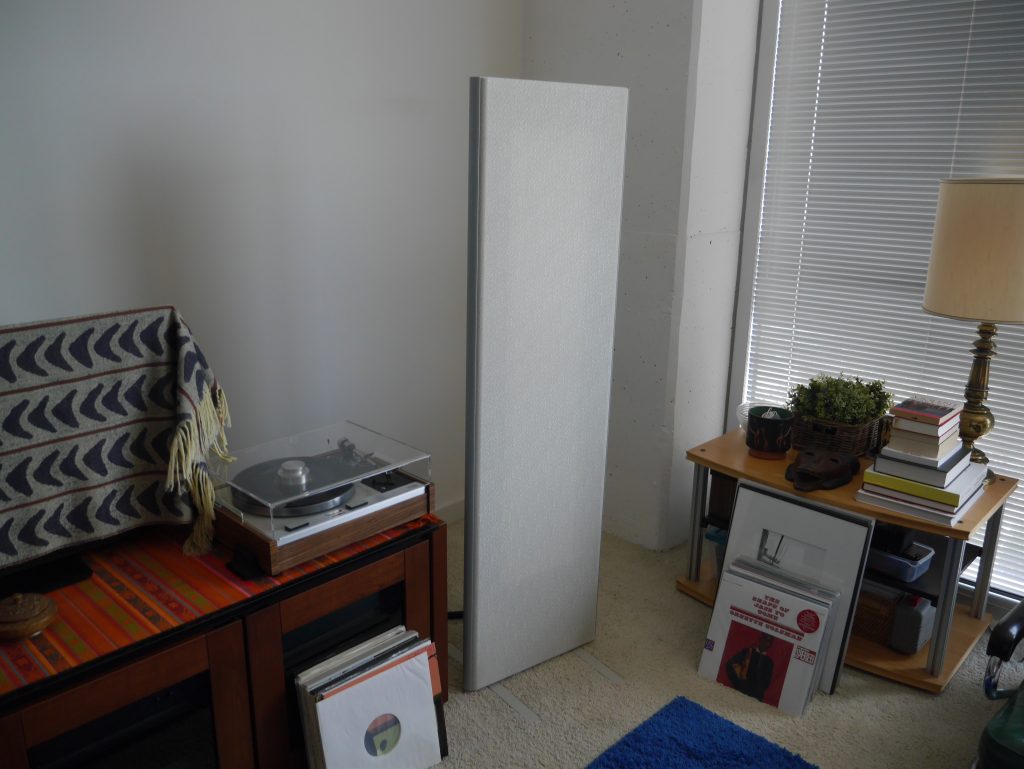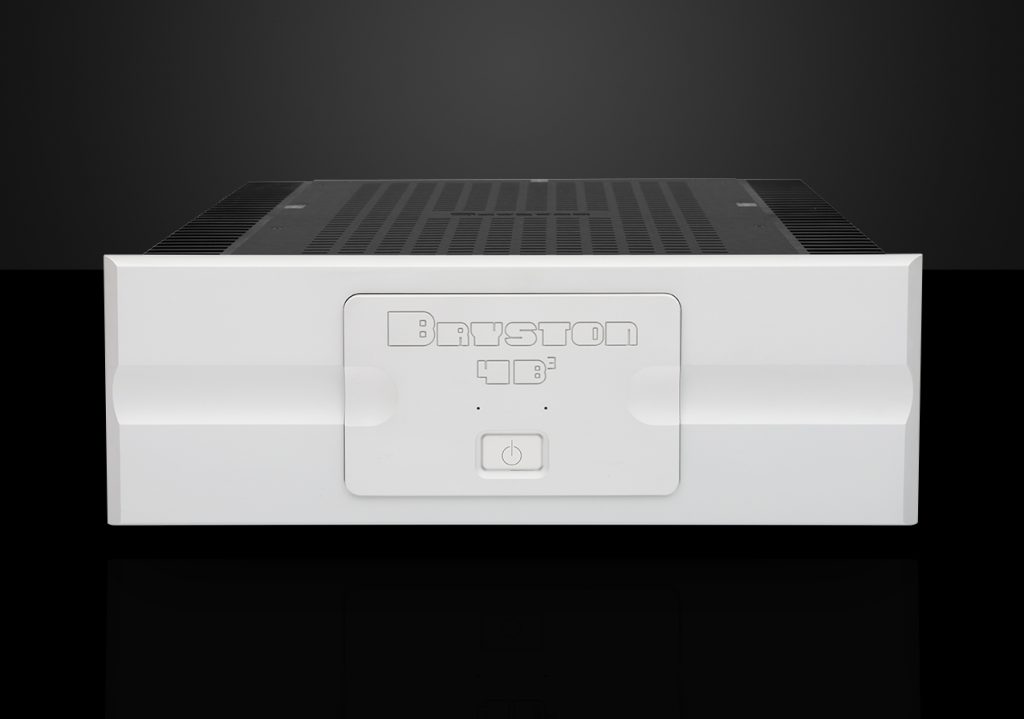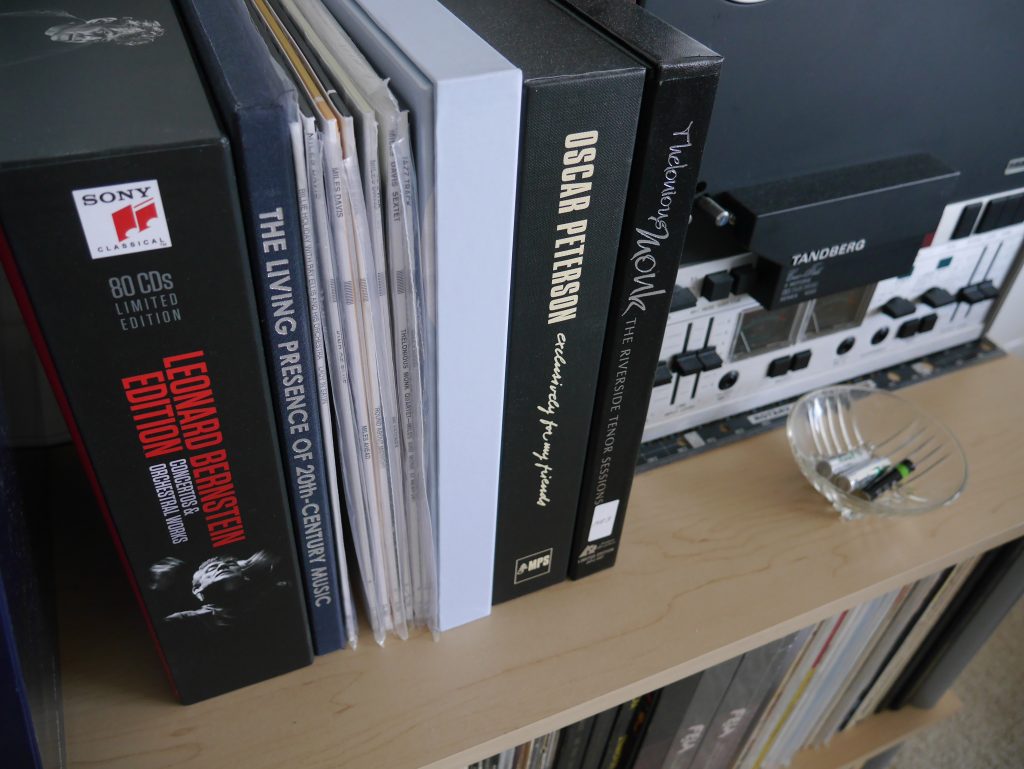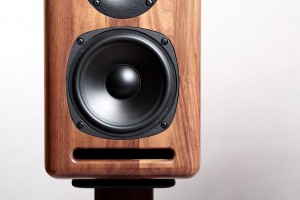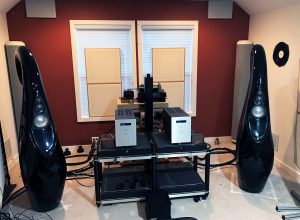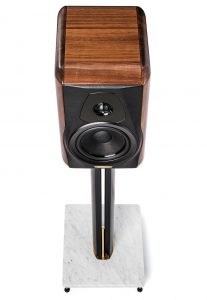First Impressions
As I reported in Part 1 of this installment, I first encountered the Maggie 1.7 loudspeakers (recently upgraded to its current 1.7i iteration) during a brief audition at Audible Elegance, a respected Cincinnati area retailer, about two and a half years ago. What I heard during that brief listening session left me mightily impressed and more than a bit curious to hear what these affordable panels would sound like in my system. These potent little numbers impressed the hell out of me once again in Rosemont at AXPONA 2016, delivering some of the finest sounds at the show. Our own David Robinson agreed, bestowing on the exaSound-Magnepan-Parasound room a coveted Audio Oasis award.
More determined than ever to get my hands on a review pair, I enlisted the aid of David and Dave Clark. They put me in touch with Magnepan's affable sales and marketing manager Wendell Diller. After a series of friendly emails (and a prolonged business trip on Wendell's part), a pair of brand-spanking new Maggie 1.7is were finally headed my way.
In late April, the review pair arrived, snugly packed in a large and fairly heavy 90 lb. cardboard box only slightly taller and wider than the speakers themselves, but deep enough to accommodate both panels stacked (with plenty of padding in-between for good measure). Set-up proved straight-forward and intuitive. The supplied instructions are exercises in technical minimalism: they offer the user only what s/he needs to install the speakers successfully, but little more. Tipping the scales at a manageable 42 pounds, each panel measures 5-½' tall, 19" wide, and a scant 2" deep. The review pair came wrapped in an attractive if nondescript off-white fabric accented with silver aluminum side rails said to increase structural rigidity.
The 1.7is only accept single-wired banana plugs, which I don't own. Fortunately, supplied adapters permit the use of spades, my preferred mounting method. Because my reference Silnote Orion M2 speaker cables are a bit on the heavy side, I used Cable Elevators both to isolate the cables from airborne vibrations and to elevate the runs so as to minimize any weight-induced strain on the speaker binding posts. In my listening/living room, the speakers ended up sounding their best when placed exactly 3' from the rear wall, at least two feet away from all side walls and encumbrances, and 9-½' apart, along with a bit of modest but noticeable toe-in. During a follow-up phone call Wendell informed me that adequate toe-in is absolutely essential to bring the tweeters into correct phase with the mid-bass drivers.
Like the previous 1.7s, the upgraded model employs a three-way quasi-ribbon driver arrangement that consists of separate mid-bass, tweeter and super-tweeter elements. Magnepan's quasi-ribbon driver technology bonds a true ribbon element (here constructed of ultra-thin aluminum foil) to a thin layer of mylar film. This quasi-ribbon drivers afford users most of the sonic benefits of true ribbon technology, namely superb speed of attack, extremely low distortion levels, extraordinary treble purity, class-leading transparency, and high power handling, but not quite to the same degree (but at a lower cost).
In contrast, Magnepan's true ribbons (used in the pricier 20.7 and 3.7i tweeters) utilize the above-mentioned ultra-thin pure aluminum foil structure exclusively in order to achieve a purer, more refined presentation. The pure ribbon arrangement places micro-thin aluminum foil strips (reportedly only 1/10th the thickness of a human hair) between driving magnets that run the length of the ribbon element. This architecture permits the drive current from the amplifier to power or "drive" the ribbon over its entire operating surface, thereby moving the requisite air needed to produce Maggie's signature open sound. Because Magnepan's true and quasi-ribbon drivers dispense with voice coils, driver surrounds, and of course, cones and boxes, the result is music that sounds, at least to these ears, fundamentally more open, transparent and box-less than typical box speakers.
When I pressed Wendell to describe the differences between the 1.7s and the 1.7is, all he would say is that blind listening panels made up of both seasoned audiophiles and casual listeners were used to verify that the trickle-down "i" upgrades delivered not just improved measured performance, but better sounding speakers as well.
New Speakers, Cousin Joe, and the Vagaries of System Tweaking
Straight out of the box the Maggies offered an open, coherent window on the music, even while sounding a bit thin in the bass and two-dimensional. Still, early impressions were promising. As the speakers continued to break in (Maggies are notorious for requiring hundreds of hours of steady break-in time to come on song), I became more convinced of their potential greatness, but also concerned that my long-term reference power amp, Cambridge Audio's typically fine-sounding 840W, couldn't tease out of the Maggies all of the performance plateaus available. Low level late night listening sessions, for example, didn't sound quite as effortless as some scribes have reported, and the unmistakable "you are there" magic I experienced with other Maggie setups never fully materialized in my listening room. Certainly my reference Parasound JC-2/Cambridge pre/power combo sounded good driving the Maggies, but the set-up never quite managed to deliver what I would call truly engaging sound.
Enter the exciting new Bryston 4B3 stereo power amplifier (review forthcoming), which arrived at my front door in early June. Ordinarily, I would have waited until I had wrapped up the Maggie 1.7i review before replacing the Cambridge, so close was I to finishing the project. But the 4B3 came with 100 hours of pre-shipping burn time and claims from Micah Sheveloff of WIRC Media (Bryston's media rep and outside marketing strategist) that the amp required a scant 25-30 hours of additional cooking time.
Yeah, said I (to myself)! I've heard that one before. But lo and behold, the 4B3 really did come on song after only a couple of days of use. Micah was spot on. The performance gains over the very fine 840W were, at least to my ears, neither subtle nor unfairly priced. All of my subsequent listening observations reflect the sound of the Maggies, and the system as a whole, with the Bryston 4B3 in the loop.
I experienced another boost to overall system performance in the form of a totally unexpected phone call from my dear cousin Joseph shortly after the Bryston arrived. You see, Cousin Joe (he really is my cousin, and a first cousin once removed at that) is a life-long audiophile, fellow music lover, and close confidant. Joe had just purchased Cambridge Audio's brilliant Azur 851D DAC from Audio Advisor (for a scant $800) and had called enthusiastically imploring me to do the same. Joe is quite the unofficial pitchman for recordings and close-out products he really likes.
Soon thereafter, I received an email from the good folks at Audio Advisor confirming my purchase of a silver 851D (I'm often a sucker for Cousin Joe's recommendations, as he sometimes is for mine). A few days later the 851D was up and running in my reference system. My attention then turned to securing a transport good enough to test the 851D's mettle, my old NAD M55 no longer up to the task. A follow-up phone call with Cousin Joe (are you sensing a pattern here?) offered the solution: the forgotten Emotiva ERC-3 Balanced CD player/transport that had lain fallow in my bedroom headphone system for well over a year (and a steal at $499).
With the Emotiva now serving as dedicated transport, I experienced pure, organic and distinctly analog-sounding music, all from humble red book CDs. The sound of the Emotiva ERC-3/851D combo soundly trounced that of the NAD M55/851D pairing in every conceivable way. (BTW: I'm using Audio Sensibility's superb Statement Silver AES/EBU digital cable to link transport to DAC. Thanks go out to our own Bruce Kinch for providing the heads-up on this affordable, beautifully-built, superb-sounding cable line in his recent Audio Sensibility cable review).
Now I was ready to hear what the Maggies really had to offer.
I got the speaker break-in blues
As I indicated earlier, fresh from the box, I heard more or less what I expected from the 1.7is: a bass-light sound with limited sound stage depth. Unexpectedly, I also noticed a pronounced treble peak that made just about everything I played sound a bit hot and forward. In all fairness, the speakers weren't to blame here. Rather, my largely untreated, high-ceilinged listening room, along with a moderately reflective back-wall, were the likely culprits. The key to taming this coloration proved easier than I imagined. After consulting Magnepan's superb owner's manual, I discovered that one can ameliorate treble anomalies caused by room reflections by inserting a pair of supplied 1.2-ohm ceramic resistors in place of the standard jumpers.
Reassuringly, the resistors did indeed tame the speaker's mildly hot treble, producing both a smoother, sweeter top-end (but with no perceived diminution in upper-octave air and extension), and better overall driver integration. Stated another way, the resistors bought the tweeter range into better balance with the midrange and bass regions, thereby improving overall tonality and coherence, but also sharpening perceived sound stage width, depth and height cues.
Sonic Impressions
With everything in alignment (and after more than 400 hours of break-in time), the 1.7is distinguished themselves as amongst the most coherent, natural, and downright realistic sounding transducers ever to grace my listening room. Boasting superb top-to-bottom coherence, crisp timing, credible bass dynamics (into what sound like the mid-40s), plus excellent imaging and wall-to-wall staging, they provide a virtual 3-D window view into the music. Importantly, I detected no speaker preference for vinyl over digital sources; both sounded great, but recording quality does matter. Great recordings sound refreshingly alive, whether analog or digital, but poor recordings have little room to hide. Mercifully, such recordings simply sound uninspiring through the little Maggies, but rarely if ever outright unlistenable.
To my surprise, the first aspect of the sound that grabbed my attention was the speaker's bass performance. Taught, tuneful, and laser-quick, bass through the 1.7is possesses a tangible, tactile quality, an almost 3-D palpability that sounds nothing like bass reproduced by ordinary box speakers. Perhaps it comes down to the dipole room loading and the fact that sound propagates from a much larger surface area than with dynamic drivers, but the naturalistic way that these slim panels do bass more than compensates for their limited actual bass reach and punch. (My ears tell me that my listening room may be responsible for a slight 1-2dB mid-bass boost in the 50-60 Hz region that I think I sometimes hear, but this is just speculation as I only hear this artifact on some recordings. I plan to take some measurements of the room over the coming weeks to sort things out. I will report my findings when I have an answer).
Moving up the frequency ladder, the Maggie quasi-ribbon midrange portrays instruments and vocals, and tonal colors and timbres, with unwavering fidelity. Voices, especially female, possess an almost ethereal transparency and sense of openness. From Betty Carter's earthy sensuality to Maria Callas' timeless coloratura, the 1.7is capture every inflection and musical turn of phrase. Instruments, particularly woodwinds and brass, sound surprisingly natural. If you know what a saxophone or trumpet really sounds like, I think you will be quite amazed at how closely these things get to replicating the actual sound - the attack, tone and timbre - of these instruments in a home listening environment.
Much of this comes down to the speaker's superb transient capabilities and the use of the same driver material for all three drivers. As I noted in my review of the superb KingSound Prince III electrostatic speakers for StereoTimes, one cannot (and arguably should not) separate a given component's (and a given system's) ability to reproduce accurately musical transients from a given component or system's tonal capabilities. These qualities very much represent two sides of the same sonic coin. As I argued then, the accurate reproduction of musical transients is what allows listeners to distinguish between the sound of, say, a trumpet and a cornet. I praised the Prince III's for their superb ability to reproduce initial musical transients, musical sustains, and instrumental and vocal decays as a continuous, sonically uninterrupted event.
Much of what I love about electrostatic speakers applies in near equal measure to the 1.7is. They wed class-leading transient performance to some of the most realistic instrumental decays this side of audio nirvana. High-hats, snares and cymbals sparkle, shimmer, and recede naturally into the sonic background. Acoustic bass plucks snap with superb speed and excellent tonal focus.
Even more convincing is the way the speakers reproduce drums of various types. Given my love of mini monitors, one area where almost every example of that much-maligned breed falls short lies in their inability to reproduce realistically a drum kit's dynamic envelope, and perhaps more importantly, the kit's unique timber and tone (yes, dear friends, rhythm instruments also have tonal signatures). Through most minis, drum kits tend to sound dynamically compressed and "hooded". I suspect that this is the result of your typical 5 or 6-inch mid-bass driver reaching its dynamic saturation point (sometimes described as the driver operating outside of its optimal moment of inertia parameters, so to speak) well before the drum kit has achieved its optimal moment of dynamic and tonal inertia. There's only so much sound small drivers can propagate into the listening room, after all.
(For a fascinating discussion on this topic, I refer those of you with scientific leanings to William Cardenas and Wolfgang Klippel's Loudspeaker Rocking Modes (Part 1: Modeling) HERE).
In contrast, the Maggies emit sound over the entirety of their exposed radiating surface, front and back; in other words, in classic dipole fashion. So while they are typically less sensitive and therefore unable to match the overall maximum loudness capabilities of big dynamic driver systems (although they are 3-4 dBs more efficient than typical electrostatic speakers), where they play, they do so with typically less distortion and compression, that is until they reach their loudness range limits. Despite considerable effort, I never reached the speaker's loudness limits, nor did I have a desire to do so, so confidently does the 1.7i play from moderately soft to genuinely loud. For night owls, their ability to play coherently at lower levels means that one can enjoy a jazz or string quartet even while loved ones' slumber in the next room.
In the treble region, the 1.7i sounds wonderful, even while lacking a wee bit of the ultimate shimmer, sheen and tactile action that one hears with the very best beryllium tweeters (think Magico, Focal or our own Greg Weaver's reference Von Schweikert VR-55s). Utterly free of grit and grain, they are paragons of smoothness and sweetness. The Maggie top-end is also highly revealing of ambient and sound staging cues embedded in the best recordings. On something like Dorati and the Detroit Symphony Orchestra's late analog-era collection of Bartók warhorses (Bartók Suite No.1; Two Pictures - Decca 478-5959 CD), one hears (or perhaps senses) very distinctly the physical dimensions of Detroit's United Artists Auditorium, all supported by a delicious cushion of air and accompanying instrumental bloom.
In contrast, the Vijay Iyer Trio's latest reflections on Monk (Break Stuff - EMC 2420 CD) sound as if recorded in a largely sterile acoustic space. While quite transparent and liquid sounding, the recording lacks the air, extension, and upper octave life that heightens the sense that one is listening to the real thing instead of a processed studio recording. (This sense of airlessness, coupled to a seemingly rolled-off top-end, remains my biggest gripe with the sound of far too many SACDs, by the way. To my ears, the bulk of the breed sound flat and lifeless, although I recognize that others feel quite differently about the medium).
Please don't think that I'm painting all ECM recordings with the same unflattering brush. I'm not! Cadona (ECM-1-1132 LP), a 1978 vinyl treasure from the same label captures the inspired multicultural chemistry between Colin Walcott, Don Cherry and Nana Vasconcelos (all sadly deceased) with such stunning realism, upper-octave air, and holographic staging, it virtually electrifies the listening room.
Wrap up
For a very reasonable $2100 the pair, the 1.7is do what few rivals can at any price: make great recordings like Cadona shimmer and pulsate with musical life. Tonally neutral and balanced (if perhaps a touch technicolor rich), eerily holographic, and beautifully extended in the top octaves, where they play, they play with a refinement and confidence that is at times startling.
They are also extremely revealing of front-end changes and upgrades. One can drive them competently with a well-engineered product like Parasound's affordable but great-sounding Halo integrated amp ($2495) and get good results. Pair them with more refined options like those described elsewhere in this review, however, and they respond accordingly. As I noted earlier, the performance gains I observed when I replaced the fine sounding Cambridge 840W power amp with the pricier and even better-sounding Bryston 4B3 were neither subtle nor limited to a narrow frequency band. Across the board, from the top of their range down to about 45 cycles, the 1.7is consistently sounded more dynamic, composed, tonally fluid, and lifelike when driven by the 4B3.
At the price, the little Maggies aren't perfect. What is? They don't do deep bass, but if you know anything about smaller Maggies and like what they do, this will not matter much. They don't play as loudly as some speakers, especially the horn variety, but they play with sufficient grunt, vigor and composure to sound satisfyingly loud in the rooms they were designed to drive: moderate sized listening spaces. And while they cast an enormous and, at times, eerily holographic sound stage and image with reasonable precision, one will not experience the laser-precise segregation of instruments and vocalists that one does with the best compacts and minis. On the other hand, few if any small speakers can reproduce a well-recorded piano with the scale, force and impact that the 1.7is deliver. Life invariably demands trade-offs. In this case, I am more than happy to sacrifice an iota or two of imaging specificity in return for the heightened sense of realism and drama that these speakers provide. Just remember to give them the watts that they crave and the breathing space they need to perform at their best.
Very highly recommended! And yes, I bought the review pair.
Magneplanar 1.7i Quasi-Ribbon three way planar loudspeakers
Retail: $2100
Magnepan
MAGNEPAN
1645 Ninth Street
White Bear Lake, MN 55110
USA
1-800-474-1646




